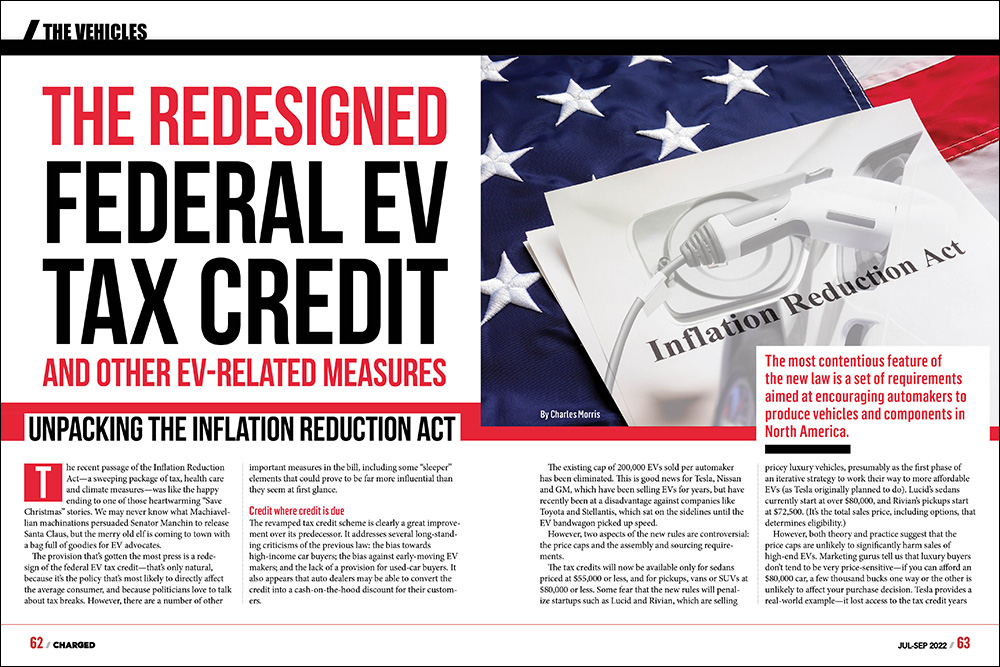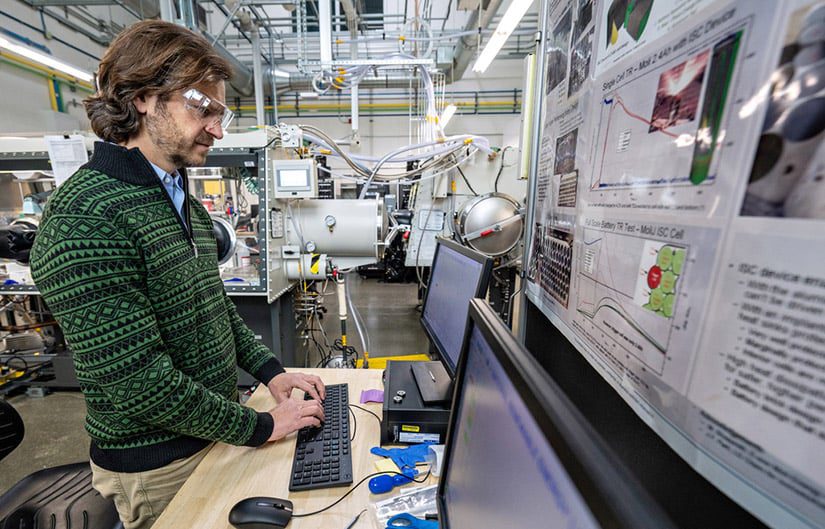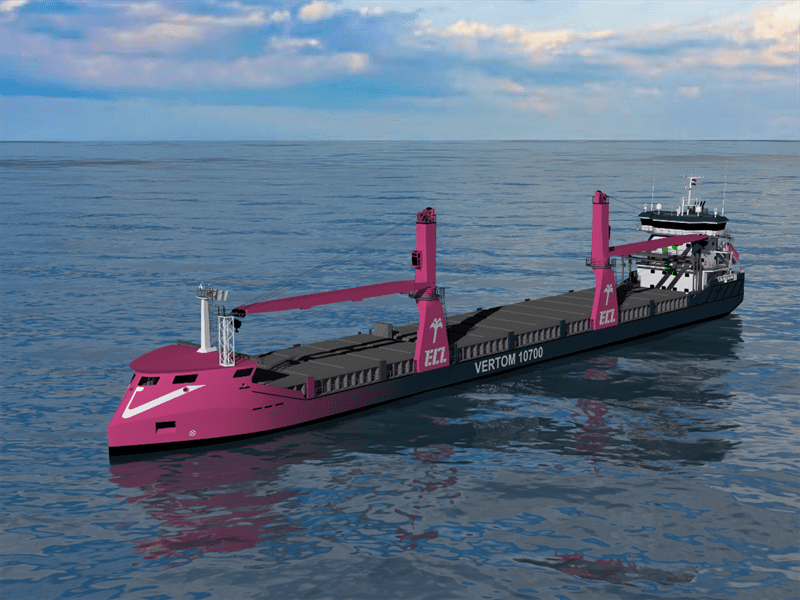Unpacking the Inflation Reduction Act
The recent passage of the Inflation Reduction Act—a sweeping package of tax, health care and climate measures—was like the happy ending to one of those heartwarming “Save Christmas” stories. We may never know what Machiavellian machinations persuaded Senator Manchin to release Santa Claus, but the merry old elf is coming to town with a bag full of goodies for EV advocates.
The provision that’s gotten the most press is a redesign of the federal EV tax credit—that’s only natural, because it’s the policy that’s most likely to directly affect the average consumer, and because politicians love to talk about tax breaks. However, there are a number of other important measures in the bill, including some “sleeper” elements that could prove to be far more influential than they seem at first glance.
Credit where credit is due
The revamped tax credit scheme is clearly a great improvement over its predecessor. It addresses several long-standing criticisms of the previous law: the bias towards high-income car buyers; the bias against early-moving EV makers; and the lack of a provision for used-car buyers. It also appears that auto dealers may be able to convert the credit into a cash-on-the-hood discount for their customers.
The existing cap of 200,000 EVs sold per automaker has been eliminated. This is good news for Tesla, Nissan and GM, which have been selling EVs for years, but have recently been at a disadvantage against companies like Toyota and Stellantis, which sat on the sidelines until the EV bandwagon picked up speed.
However, two aspects of the new rules are controversial: the price caps and the assembly and sourcing requirements.
The tax credits will now be available only for sedans priced at $55,000 or less, and for pickups, vans or SUVs at $80,000 or less. Some fear that the new rules will penalize startups such as Lucid and Rivian, which are selling pricey luxury vehicles, presumably as the first phase of an iterative strategy to work their way to more affordable EVs (as Tesla originally planned to do). Lucid’s sedans currently start at over $80,000, and Rivian’s pickups start at $72,500. (It’s the total sales price, including options, that determines eligibility.)
The most contentious feature of the new law is a set of requirements aimed at encouraging automakers to produce vehicles and components in North America.
However, both theory and practice suggest that the price caps are unlikely to significantly harm sales of high-end EVs. Marketing gurus tell us that luxury buyers don’t tend to be very price-sensitive—if you can afford an $80,000 car, a few thousand bucks one way or the other is unlikely to affect your purchase decision. Tesla provides a real-world example—it lost access to the tax credit years ago, and has raised its prices several times since then, with no discernable negative effect on demand.
The most contentious feature of the new law is a set of requirements aimed at encouraging automakers to produce vehicles and components in North America. To be eligible for the full credit, a vehicle must be assembled in the US; at least 50% of the components in the battery must come from the US, Canada or Mexico by 2024, and 100% by 2028; and at least 40% of the raw minerals in the battery must come from the US or “a trade ally” in 2024, and 80% in 2026.
The New York Times’ Jack Ewing writes that the package “aims to achieve two goals that are not always compatible: Make electric vehicles more affordable while freezing China out of the supply chain.” To qualify for tax credits under the new rules, “the cars and their batteries have to meet made-in-America requirements that many carmakers cannot easily achieve.”
The package aims to achieve two goals that are not always compatible: Make electric vehicles more affordable while freezing China out of the supply chain… The cars and their batteries have to meet made-in-America requirements that many carmakers cannot easily achieve.
This is a legitimate area of concern, but the naysayers seem to be assuming that automakers won’t be able to change their strategies in response to the new rules. Like fuel economy standards, the new tax credit regime can be seen as a “technology-forcing” regulation. Automakers who fail to meet federal mileage standards are subject to fines, but the point of the standards isn’t to collect fines—it’s to force companies to improve their technology in order to avoid the fines (and more importantly, to avoid being at a disadvantage vis a vis their competitors).
Likewise, the point of the new price targets and Buy American provisions isn’t to single out certain automakers for punishment, but rather to force all automakers to offer cheaper EVs, and to localize and clean up their supply chains. Mark Wakefield of consulting firm AlixPartners told the Times that the new rules would lead to “a laser focus on getting below the $80,000 and $55,000 caps,” and would increase adoption of battery chemistries such as LFP, which use more widely available minerals.
Complying with these provisions will obviously require a major restructuring of EV supply chains. This is widely considered to be a worthy goal, both for reasons of national security and sustainability, and it’s a goal that automakers and suppliers are already working towards. Unnamed industry executives told the Times that they should be able to revamp their supply chains enough for their products to qualify for tax credits within five years. Others are even more optimistic. Joe Britton, Executive Director of the Zero Emission Transportation Association, told the Times he would be “shocked” if it took as long as five years to bring the industry into compliance.
Some of the supply chain restrictions are subject to interpretation by regulators, and may not end up being as onerous as they appear. It appears that all manufacturers will be eligible for the $7,500 credit through next year, before content restrictions take effect in 2024. Furthermore, it appears to be up to regulators to decide exactly which components would be proscribed. For example, would batteries produced in the US by a Chinese company fall foul of the law? The point of the tax credits is to put more EVs on the road quickly, and hopefully regulators will interpret the rules accordingly.
The two leading legacy American EV-makers are on board. The goals of the new law “cannot be achieved overnight,” but the legislation “will be part of the catalyst that helps us move forward,” said GM CEO Mary Barra during a recent appearance with President Biden. “While its consumer tax credit targets for electric vehicles are not all achievable overnight, the bill is an important step forward to meet our shared national climate goals and help strengthen American manufacturing jobs,” said Ford in a statement that urged the House to pass the legislation.
It’s also worth noting that the sourcing requirements could create new business opportunities in the field of supply chain traceability. A company called Circulor provides mapping and analysis of supply chains—it says it can prove where an EV battery’s materials are mined and manufactured, and that it is already providing such services for customers including BHP, Volvo Cars, Polestar and Jaguar Land Rover. The EU is expected to enact a new regulation later this year that will require all batteries to have a digital “passport” that documents their CO2 footprints and the sources of their raw materials.
Keep on truckin’
Some believe that the IRA’s incentives for buying commercial EVs could be more significant than the more widely-publicized passenger vehicle credits. The Rocky Mountain Institute predicts that the Qualified Commercial Clean Vehicle tax credit, which provides an incentive of up to $40,000 per vehicle, will “turbocharge adoption of electric medium-duty and heavy-duty trucks.” According to RMI, the new tax credit makes owning an electric truck cheaper than owning a diesel truck in most use cases, and urban and regional electric trucks will become cheaper than legacy diesels as soon as 2023.
To obtain the full tax credit, commercial EVs will have to meet North American final assembly requirements, but apparently are not subject to the same battery and critical mineral requirements as the Clean Vehicle Credit for individuals.
The IRA also provides a 30% tax credit for installing charging infrastructure—a huge sweetener for fleets that are considering going electric.
Several other sections of the bill could encourage adoption of zero-emission trucks. There’s $1 billion in funding for a Clean Heavy Duty Vehicles rebate program, which is designed to help states, municipalities, Indian tribes and school districts to electrify bus and truck fleets. The IRA also extends existing renewable energy tax credits for utilities, which could make EV charging cleaner and cheaper.

Goin’ postal
Charged readers are already familiar with the tawdry tale of how the US Postal Service is being dragged kicking and screaming into the electric age. Postal delivery vehicles present a perfect use case for EVs, so advocates were appalled in 2021 when USPS announced plans to replace its fleet of 212,000 ancient gas guzzlers with mostly new and improved gas guzzlers and a handful of EVs. Since then, there have been lawsuits, petitions, open letters and, presumably, behind-the-scenes arm-twisting, and the agency has gradually, grudgingly increased the proportion of EVs it plans to order.
The latest figure Postmaster General DeJoy cited was $3 billion to fully electrify, and the IRA awards the agency exactly that.
To be fair, Postmaster General Louis DeJoy, a holdover from the Trump administration, has said all along that USPS would be open to electrifying its fleet as long as Congress provided adequate funding. The latest figure cited was $3 billion, and the IRA awards the agency exactly that.
Wait, there’s more!
The IRA is a vast and sprawling edifice, and there are several other sections that could directly or indirectly benefit the EV industry.
There are several different tax credits designed to help manufacturers bring production of EVs and batteries to the US. There’s also a wide array of measures aimed at supporting renewable energy generation.
Existing federal loan programs for clean energy and EVs will be expanded. Last month, the Energy Department awarded a loan of $2.5 billion to GM and LG Energy Solution to build battery factories in Michigan, Ohio and Tennessee. The department is currently reviewing 77 applications for $80 billion in loans that were submitted before the IRA was approved. The IRA will add $100 billion in funding for existing loan programs and up to $250 billion in new loan guarantees. Some of this funding is likely to find its way to EV-related projects.
“This is a sleeping giant in the law and a real gold mine in deploying these resources,” former Assistant Energy Secretary Dan Reicher told the New York Times. “This massive amount being made available is a big deal.”
EV-related measures in the Inflation Reduction Act
Clean Vehicle Credit
$7,500 consumer credit for the purchase of an EV, PHEV or fuel cell vehicle.
- To claim the full credit, a certain percentage of battery raw materials must be extracted or processed in the US or a Free Trade Agreement country, or recycled in North America. Required percentage increases from 40% in 2024 to 80% in 2026.
- To claim the full credit, an EV must be assembled, and a certain percentage of battery components must be sourced, in North America. Required percentage increases from 50% in 2024 to 100% in 2028.
- Only cars priced at $55,000 or less, and pickup trucks, SUVs, and vans priced at $80,000 or less, are eligible.
- Only buyers with annual income of $150,000 or less ($300,000 for joint filers) are eligible.
- The cap of 200,000 vehicles sold for each automaker is eliminated.
Previously Owned Clean Vehicle Credit
Used EVs or PHEVs are eligible for a credit of $4,000 or 30% of vehicle cost, whichever is less.
- Vehicles must be at least 2 years old, and have a maximum sale price of $25,000.
- Only buyers with annual income of $75,000 or less ($150,000 for joint filers) are eligible.
Qualified Commercial Clean Vehicles Credit
Class 1-3 (under 14,000 lbs) commercial vehicles are eligible for a $7,500 tax credit. Class 4-8 (over 14,000 lbs) vehicles are eligible for a tax credit of $40,000, or 30% of vehicle cost, whichever is less.
Alternative Fuel Refueling Infrastructure Credit
Tax credit of 30% of the installed cost of charging stations, up to a lifetime benefit of $100,000 per site.
Funding for US Postal Service electrification
$3 billion in funding for USPS to convert its fleet to EVs.
Manufacturing credits
Various tax credits to help manufacturers establish or expand manufacturing of EVs and batteries in the US.
Clean Heavy-Duty Vehicles
$1 billion in grants for up to 100% of costs for heavy-duty EVs (school buses, refuse trucks, etc). States, municipalities, Native American tribes, and nonprofit school transportation agencies are eligible.
Clean Energy Financing
$100 billion in new funding for existing DOE loan programs and up to $250 billion in new loan guarantees.
This article appeared in Issue 61: Jul-Sep 2022 – Subscribe now.


















































































